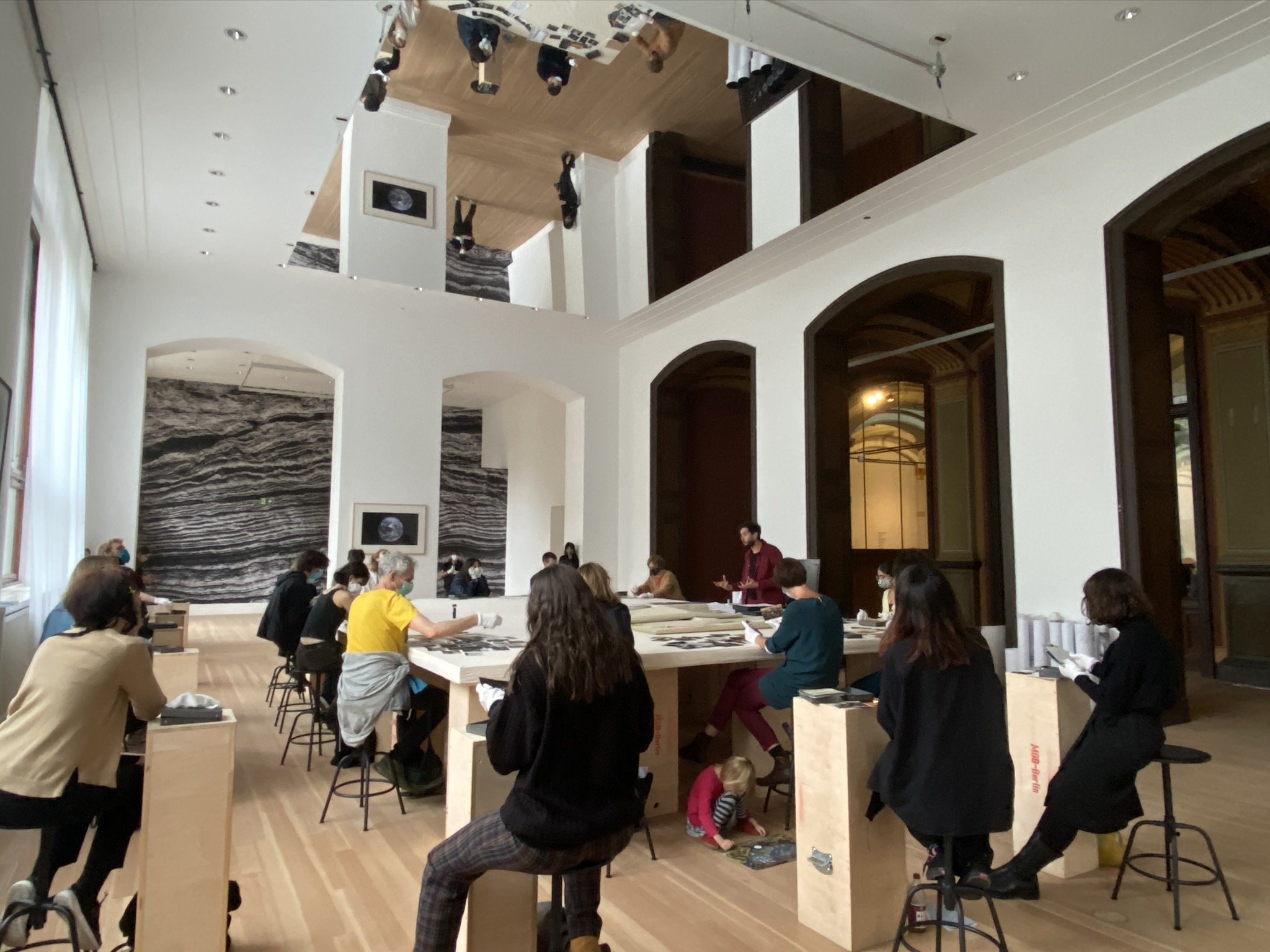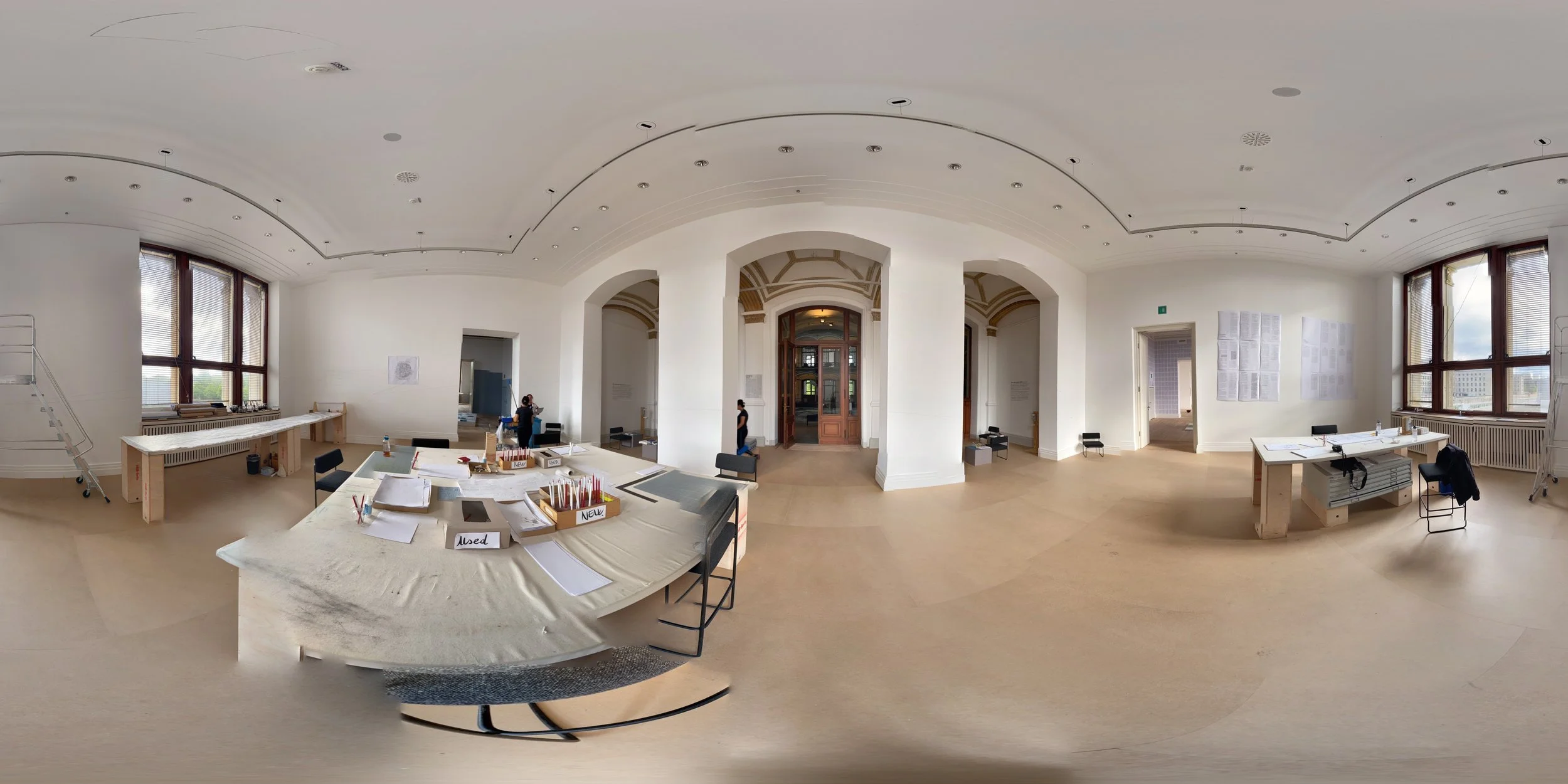Aufführungsraum
-
2020
Lieu : Gropius Bau, Berlin – exposition Down to Earth (curation : Tino Sehgal)
Format : Installation performative in situ
Médium : Papier, graphite, textile, photographie, matériaux bruts, lumière naturelle, son, dessin in situ
Dispositif : Grande table centrale en bois (9 x 4 m), miroir suspendu au plafond (6 x 4 m), papier, graphite, matériaux collectés sur site, textiles amovible (6 x 9 m, en 2 exemplaires), photographies encadrées, cartons, lumière naturelle, rideaux, acoustique du lieu ; atelier intégré à l’espace d’exposition pour la réalisation de dessins sur place
Dimensions : Variables selon l’espace -
2020
Location: Gropius Bau, Berlin – Down to Earth exhibition (Curated by Tino Sehgal)
Format: In situ performative installation
Medium: Paper, graphite, textile, photography, raw materials, natural light, sound, in situ drawing
Setup: Large central wooden table (9 x 4 m), suspended mirror on the ceiling (6 x 4 m), paper, graphite, materials collected on site, removable textiles (6 x 9 m, 2 pieces), framed photographs, cardboard, natural light, curtains, site acoustics; workshop integrated into the exhibition space for on-site drawing production
Dimensions: Variable, depending on the space
-
Dans le prolongement de la collaboration avec Bruno Latour et Frédérique Aït-Touati sur Inside et Moving Earths, le projet présenté au Gropius Bau en 2020 dans le cadre de la curation de Tino Sehgal s’inscrivait dans une démarche de recherche et d’expérimentation in situ.
Down to Earth, pensé comme une exposition sans électricité, sans projections numériques ni lumière artificielle, imposait un cadre radical où le rapport au temps, à l’espace et aux matières devenait central.
Durant une résidence d’un mois sur site, un travail in situ a été mené autour d’une installation performative évolutive. L’enjeu était de traduire les principes développés dans Inside et Moving Earths—questionnant les dynamiques terrestres et la relation entre humains et non-humains—dans un contexte où seule la lumière naturelle et la présence des corps structuraient l’expérience.
L’installation s’articulait autour d’une grande table centrale, un espace à la fois physique et conceptuel où les participants, chercheurs, artistes et visiteurs engageaient un dialogue continu. L’atelier mis en place au sein de l’exposition permettait une transformation progressive du dispositif : gestes répétés, tracés accumulés, déplacements modulés en fonction de la lumière et de l’acoustique du lieu.
Ce travail in situ explorait une écologie de l’attention et de la perception, en accord avec les principes curatoriaux de Sehgal, où la présence et l’expérience directe du vivant prenaient le pas sur toute forme de représentation. À travers cette résidence, l’installation s’est construite comme un processus en mouvement, interrogeant la manière dont nous habitons et percevons notre environnement dans un contexte de crise écologique.
-
Following the collaboration with Bruno Latour and Frédérique Aït-Touati on Inside and Moving Earths, the project presented at the Gropius Bau in 2020 as part of Tino Sehgal’s curatorial program was rooted in a process of in situ research and experimentation.
Down to Earth, conceived as an exhibition without electricity, digital projections, or artificial lighting, imposed a radical framework in which time, space, and materials became central.
During a one-month on-site residency, an in situ process unfolded around an evolving performative installation. The aim was to translate the principles developed in Inside and Moving Earths—exploring earthly dynamics and the relationship between humans and non-humans—into a context where only natural light and the presence of bodies shaped the experience.
The installation revolved around a large central table, a space that was both physical and conceptual, where participants—researchers, artists, and visitors—engaged in an ongoing dialogue. The workshop established within the exhibition allowed for a progressive transformation of the setup: repeated gestures, accumulated traces, movements adapted to the light and acoustics of the space.
This in situ work explored an ecology of attention and perception, in line with Sehgal’s curatorial principles, where presence and direct experience of the living took precedence over any form of representation. Through this residency, the installation unfolded as a process in motion, questioning how we inhabit and perceive our environment in the context of ecological crisis.





